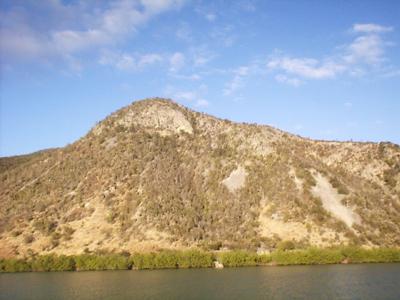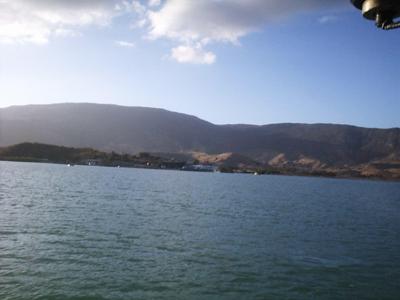

Baitiquiri (Cuba)
20° 01 N 074° 51 W
| Page 1 of 1 |
08 February 2001 - 15 February 2001
The entrance at Baitiquiri is about 60 feet wide and we just managed to
squeeze through the little gap. Inside, the bay is protected all round by
grass laden hills. The water is green and you can't see 1 foot beneath the
surface of the water. The Customs men came out in a little rowing boat and
told us to keep the VHF on channel 16. Well, when we wanted to leave we
called them every half hour for days with no response. Finally, dad threw a
yellow soap bottle over the side, the Naval men approached it carefully,
read the note. One hour later we were on our way to the Bahamas. YIPPY :)
Our sail to the Bahamas through the Windward passage was terrible with wind
and current against us. We were doing a pathetic 2.5 knots.
Arriving at Great Inagua and from what I could see through the saloon
window, I knew I was going to enjoy the Bahamas.
Liz
We waited a week in Baitiquiri for the weather to change. As it turns out we should have waited longer. What do you do when you are confined to the boat, and can't even launch the dinghy because you have officially left Cuba? You get "Cabin Fever" and everyone goes slightly mad and....
|
Jack attacks an oven glove while |
Michael attacks Laura, then Jack attacks Michael, then.... |
|
Laura has to prove she is OK to Jack. |
Granny in the meantime listens to "Sting" on the Walkman. |
|
We also read, to pass the time. |
Or we just schloff-out and waited. |

It was very dry here, only the mangrove trees, able to grow and thrive in seawater, remained green.

Although you cant see very much here, in the distance is a Cuban navy base. A funny thing happened. We were at anchor here for one week watching the navy boys do their painting and saluting. When we arrived the Guarda Frontiera came to see us and we explained that we had cleared out of Cuba, and were on our way to the Bahamas. We also said that the weather in the windward passage was very bad, and we asked if we could stay for a few days. They are not really allowed to give us such permission, so to allay any fears we promised that we would not even launch the dinghy, or get into the water. They seemed a bit more relaxed but still insisted on keeping our papers, ships registration etc ashore, and asked us to call on channel 16 VHF before leaving and they would return the docs to us.
When the weather according to **#^#&$ on the radio (he was wrong AGAIN) cleared up, we called and called on the radio, no response, we flashed with a heliograph, no response, we blew the horn waved our arms etc etc. all to no avail, sofinally I realised that the wind was blowing directly toward them. We took an old dishwash liquid bottle out of the gash and wrote a note on it something like this "Barco valero Gilana salida Baitiquiri hoy. El capitanea tengo el despacho y otros documentos. Por favor ....etc" or words to that effect. I tossed this into the water, while watching to see that they were looking my way at the time. I followed the bright yellow bottle all the way ashore with the binoculars. When it arrived ashore there was a bit of a commotion, and one fellow in a bullet proof jacket and a visor sneaked up on my bottle, he produced a pair of binoculars and crept on his tummy hiding behind rocks and studied it well. He then went back and got a loooong pole with a net, and scooped it up. and took it to his superior who boldly took it at arms length between thumb and forefinger and examined it. It finally went to the Capitanea, who returned our documents and we left at 17h00 later that day. We had a good laugh at the suspicious nature of the sailors, but, also wondered if this suspicion of foreigners was perhaps trained into them. Perhaps it was because we were adversaries in Angola?

At 17h10 we passed out of the mouth of the pocket bay of Baitiquiri. It was the narrowest entrance we have negotiated. The navigation marks just visible, are sixty feet apart. It was fun surfing the boat into here with a large swell. The only way to do it is to follow the advice of others who have done it and open the throttle with blind faith, once lining up the marks with the dock in the distance. From seaward you cant even see the marks behind the striped backs of the breaking waves. The most important thing is to keep water flowing past the rudder, in other words, keep the throttle open so that the breaking waves are being overtaken by the boat, not the other way around.
That's it for Cuba, Later that night we went through the windward passage, go
to journals to read about it.